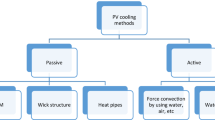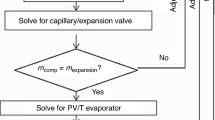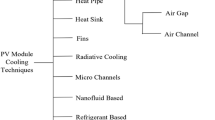Abstract
In this research, the effects of using water flow for cooling PV cell are numerically investigated. In this regard, computational fluid dynamics are applied to assess the impacts of solar irradiance, ambient temperature, and mass flow rate of cooling water on the temperature of the cell and its efficiency. Three different ambient temperatures, including 25 °C, 35 °C and 45 °C in addition to three solar irradiances in the range of 600–1000 W m−2 are considered in the modeling procedure to investigate their impacts. Moreover, the velocity of water at the inlet of the cooling channels varied between 0.5 and 0.9 m/s. Results indicated that this cooling approach is more efficient in cases of high ambient temperatures and solar irradiances. Besides, it is found that the increase in the mass flow rate of cooling water has little impact at high flow rates. The highest enhancement in the efficiency of the cell in comparison with the reference condition is observed at the ambient temperature of 45 °C, solar irradiance of 1000 W m−2, and water velocity equal to 0.9 m s−1, which is approximately 17.12%.








Similar content being viewed by others
References
Maleki A, Nazari MA, Pourfayaz F. Harmony search optimization for optimum sizing of hybrid solar schemes based on battery storage unit. Energy Reports 2020.
Cai W, Li X, Maleki A, Pourfayaz F, Rosen MA, Nazari MA, et al. Optimal sizing and location based on economic parameters for an off-grid application of a hybrid system with photovoltaic, battery and diesel technology. Energy. 2020;20:117480.
Zhang W, Maleki A, Rosen MA. A heuristic-based approach for optimizing a small independent solar and wind hybrid power scheme incorporating load forecasting. J Clean Prod. 2019. https://doi.org/10.1016/j.jclepro.2019.117920.
He W, Namar MM, Li Z, Maleki A, Tlili I, Safdari Shadloo M. Thermodynamic analysis of a solar-driven high-temperature steam electrolyzer for clean hydrogen production. Appl Therm Eng. 2020;172:115152. https://doi.org/10.1016/j.applthermaleng.2020.115152.
Sze SM, Ng KK. Physics of semiconductor devices. 3rd ed. Wiley: New York; 2007.
Hernández-Callejo L, Gallardo-Saavedra S, Alonso-Gómez V. A review of photovoltaic systems: design, operation and maintenance. Sol Energy. 2019;188:426–40. https://doi.org/10.1016/j.solener.2019.06.017.
Dimri N, Tiwari A, Tiwari GN. Thermal modelling of semitransparent photovoltaic thermal (PVT) with thermoelectric cooler (TEC) collector. Energy Convers Manag. 2017;146:68–77. https://doi.org/10.1016/j.enconman.2017.05.017.
Thirugnanasambandam M, Iniyan S, Goic R. A review of solar thermal technologies. Renew Sustain Energy Rev. 2010;14:312–22. https://doi.org/10.1016/j.rser.2009.07.014.
Europe S. Global market outlook for solar power 2018–2022. Brussels: Solar Power Europe; 2018.
Almosni S, Delamarre A, Jehl Z, Suchet D, Cojocaru L, Giteau M, et al. Material challenges for solar cells in the twenty-first century: directions in emerging technologies. Sci Technol Adv Mater. 2018;19:336–69. https://doi.org/10.1080/14686996.2018.1433439.
Sandwell P, Chan NLA, Foster S, Nagpal D, Emmott CJM, Candelise C, et al. Off-grid solar photovoltaic systems for rural electrification and emissions mitigation in India. Sol Energy Mater Sol Cells. 2016;156:147–56. https://doi.org/10.1016/j.solmat.2016.04.030.
Maleki A, Askarzadeh A. Optimal sizing of a PV/wind/diesel system with battery storage for electrification to an off-grid remote region: a case study of Rafsanjan, Iran. Sustain Energy Technol Assess. 2014;7:147–53. https://doi.org/10.1016/j.seta.2014.04.005.
Maleki A, Pourfayaz F, Ahmadi MH. Design of a cost-effective wind/photovoltaic/hydrogen energy system for supplying a desalination unit by a heuristic approach. Sol Energy. 2016;139:666–75. https://doi.org/10.1016/j.solener.2016.09.028.
Zhang W, Maleki A, Rosen MA, Liu J. Sizing a stand-alone solar-wind-hydrogen energy system using weather forecasting and a hybrid search optimization algorithm. Energy Convers Manag. 2019. https://doi.org/10.1016/j.enconman.2018.08.102.
James A, Mohanraj M, Srinivas M, Jayaraj S. Thermal analysis of heat pump systems using photovoltaic-thermal collectors: a review. J Therm Anal Calorim. 2020. https://doi.org/10.1007/s10973-020-09431-2.
Alhuyi NM, Aslani A, Ghasempour R. Analysis of solar farm site selection based on TOPSIS approach. Int J Soc Ecol Sustain Dev. 2018;9:56.
Tonui JK, Tripanagnostopoulos Y. Improved PV/T solar collectors with heat extraction by forced or natural air circulation. Int J Hydrogen Energy. 2006;31:2137–46. https://doi.org/10.1016/j.ijhydene.2006.02.009.
Al-Waeli AHA, Chaichan MT, Sopian K, Kazem HA, Mahood HB, Khadom AA. Modeling and experimental validation of a PVT system using nanofluid coolant and nano-PCM. Sol Energy. 2019;177:178–91. https://doi.org/10.1016/J.SOLENER.2018.11.016.
Du Y. Advanced thermal management of a solar cell by a nano-coated heat pipe plate: a thermal assessment. Energy Convers Manag. 2017;134:70–6. https://doi.org/10.1016/J.ENCONMAN.2016.11.059.
Mohanraj M, Chandramohan P, Sakthivel M, Kamaruzzaman S. Performance of photovoltaic water pumping systems under the influence of panel cooling. Renew Energy Focus. 2019;31:31–44. https://doi.org/10.1016/j.ref.2019.10.006.
Chinathambi G, Murugesan M, Palanisamy C, Munirajan S, Bhero S. Modeling of a solar photovoltaic water pumping system under the influence of panel cooling. Therm Sci. 2017;21:399–410. https://doi.org/10.2298/TSCI17S2399C.
Chandrasekar M, Suresh S, Senthilkumar T, Ganesh KM. Passive cooling of standalone flat PV module with cotton wick structures. Energy Convers Manag. 2013;71:43–50. https://doi.org/10.1016/j.enconman.2013.03.012.
Hasan A, Sarwar J, Alnoman H, Abdelbaqi S. Yearly energy performance of a photovoltaic-phase change material (PV-PCM) system in hot climate. Sol Energy. 2017;146:417–29. https://doi.org/10.1016/J.SOLENER.2017.01.070.
Akbarzadeh A, Wadowski T. Heat pipe-based cooling systems for photovoltaic cells under concentrated solar radiation. Appl Therm Eng. 1996;16:81–7. https://doi.org/10.1016/1359-4311(95)00012-3.
Kluth A. Using water as a coolant to increase solar panel efficiency. California: California Science and Engineering Fair; 2008.
Baloch AAB, Bahaidarah HMS, Gandhidasan P, Al-Sulaiman FA. Experimental and numerical performance analysis of a converging channel heat exchanger for PV cooling. Energy Convers Manag. 2015;103:14–27. https://doi.org/10.1016/J.ENCONMAN.2015.06.018.
Pakatchian MR, Saeidi H, Ziamolki A. CFD-based blade shape optimization of MGT-70(3)axial flow compressor. Int J Numer Methods Heat Fluid Flow. 2019. https://doi.org/10.1108/hff-10-2018-0603.
Irandoost Shahrestani M, Maleki A, Safdari Shadloo M, Tlili I. Numerical investigation of forced convective heat transfer and performance evaluation criterion of Al2O3/water nanofluid flow inside an axisymmetric microchannel. Symmetry (Basel). 2020;12:120. https://doi.org/10.3390/sym12010120.
Ramezanizadeh M, Tayebi R, Saeidi M. Large eddy simulation of multiple jets into a cross flow. Sci Iran. 2007;14:240–50.
Ramezanizadeh M, Alhuyi Nazari M, Ahmadi MH, Chau K. Experimental and numerical analysis of a nanofluidic thermosyphon heat exchanger. Eng Appl Comput Fluid Mech. 2019;13:40–7. https://doi.org/10.1080/19942060.2018.1518272.
Ghalandari M, Mirzadeh Koohshahi E, Mohamadian F, Shamshirband S, Chau KW. Numerical simulation of nanofluid flow inside a root canal. Eng Appl Comput Fluid Mech. 2019;13:254–64. https://doi.org/10.1080/19942060.2019.1578696.
Hasanpour B, Irandoost MS, Hassani M, Kouhikamali R. Numerical investigation of saturated upward flow boiling of water in a vertical tube using VOF model: effect of different boundary conditions. Heat Mass Transf Und Stoffuebertragung. 2018. https://doi.org/10.1007/s00231-018-2289-3.
Maleki A, Haghighi A, Irandoost Shahrestani M, Abdelmalek Z. Applying different types of artificial neural network for modeling thermal conductivity of nanofluids containing silica particles. J Therm Anal Calorim. 2020. https://doi.org/10.1007/s10973-020-09541-x.
Ramezanizadeh M, Ahmadi MA, Ahmadi MH, Alhuyi Nazari M. Rigorous smart model for predicting dynamic viscosity of Al2O3/water nanofluid. J Therm Anal Calorim 2018;1. https://doi.org/10.1007/s10973-018-7916-1.
Nazari MA, Ghasempour R, Ahmadi MH, Heydarian G, Shafii MB. Experimental investigation of graphene oxide nanofluid on heat transfer enhancement of pulsating heat pipe. Int Commun Heat Mass Transf. 2018;91:90–4. https://doi.org/10.1016/j.icheatmasstransfer.2017.12.006.
Gandomkar A, Kalan K, Vandadi M, Shafii MB, Saidi MH. Investigation and visualization of surfactant effect on flow pattern and performance of pulsating heat pipe. J Therm Anal Calorim. 2020;139:2099–107. https://doi.org/10.1007/s10973-019-08649-z.
Gandomkar A, Saidi MH, Shafii MB, Vandadi M, Kalan K. Visualization and comparative investigations of pulsating ferro-fluid heat pipe. Appl Therm Eng. 2017;116:56–65. https://doi.org/10.1016/J.APPLTHERMALENG.2017.01.068.
Alizadeh H, Ghasempour R, Shafii MB, Ahmadi MH, Yan W-M, Nazari MA. Numerical simulation of PV cooling by using single turn pulsating heat pipe. Int J Heat Mass Transf. 2018;127:203–8. https://doi.org/10.1016/J.IJHEATMASSTRANSFER.2018.06.108.
Du Y, Fell CJ, Duck B, Chen D, Liffman K, Zhang Y, et al. Evaluation of photovoltaic panel temperature in realistic scenarios. Energy Convers Manag. 2016;108:60–7. https://doi.org/10.1016/J.ENCONMAN.2015.10.065.
Ceylan İ, Gürel AE. Exergetic analysis of a new design photovoltaic and thermal (PV/T) System. Environ Prog Sustain Energy. 2015;34:1249–53.
Wang N, Maleki A, Nazari MA, Tlili I, Shadloo MS. Thermal conductivity modeling of nanofluids contain MgO particles by employing different approaches. Symmetry (Basel). 2020;12:206.
Komeilibirjandi A, Raffiee AH, Maleki A, Alhuyi Nazari M, Safdari Shadloo M. Thermal conductivity prediction of nanofluids containing CuO nanoparticles by using correlation and artificial neural network. J Therm Anal Calorim. 2019. https://doi.org/10.1007/s10973-019-08838-w.
Maleki A, Elahi M, Assad MEH, Alhuyi NM, Safdari SM, Nabipour N. Thermal conductivity modeling of nanofluids with ZnO particles by using approaches based on artificial neural network and MARS. J Therm Anal Calorim. 2020. https://doi.org/10.1007/s10973-020-09373-9.
Author information
Authors and Affiliations
Corresponding author
Additional information
Publisher's Note
Springer Nature remains neutral with regard to jurisdictional claims in published maps and institutional affiliations.
Rights and permissions
About this article
Cite this article
Maleki, A., Ngo, P.T.T. & Shahrestani, M.I. Energy and exergy analysis of a PV module cooled by an active cooling approach. J Therm Anal Calorim 141, 2475–2485 (2020). https://doi.org/10.1007/s10973-020-09916-0
Received:
Accepted:
Published:
Issue Date:
DOI: https://doi.org/10.1007/s10973-020-09916-0




